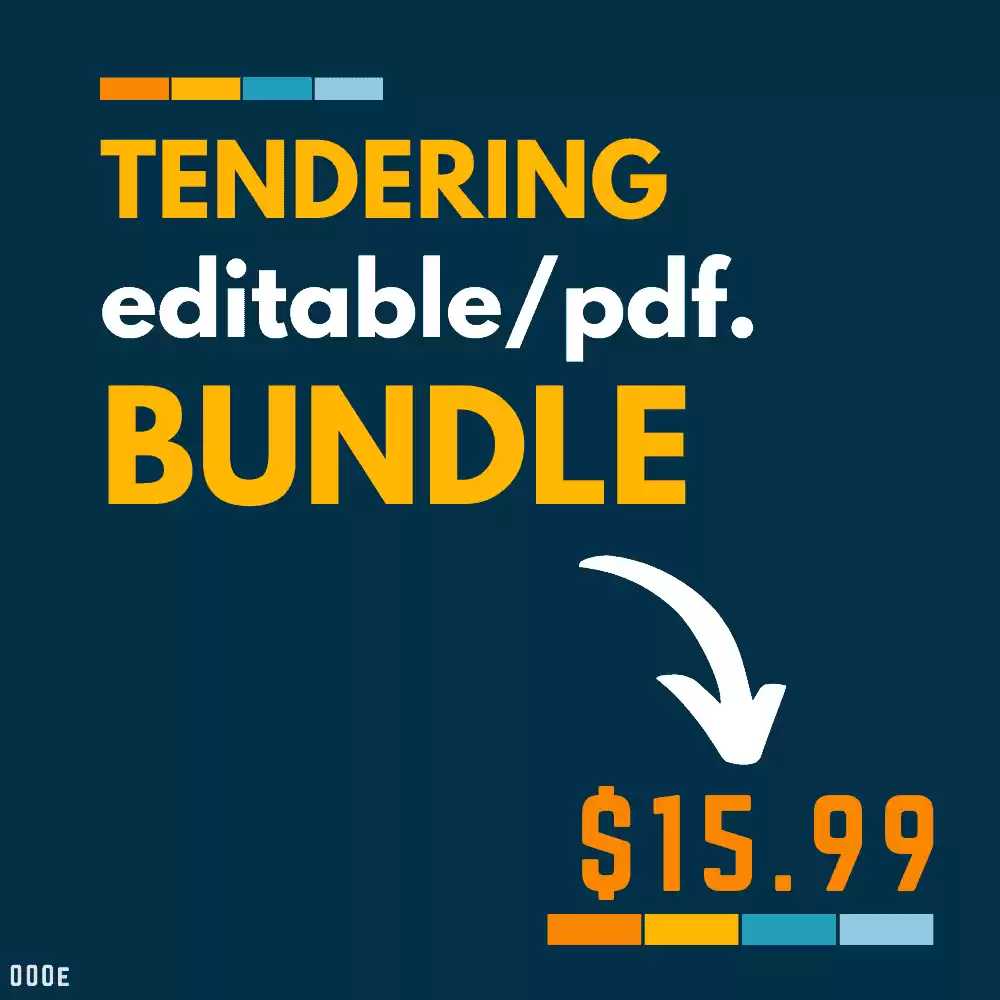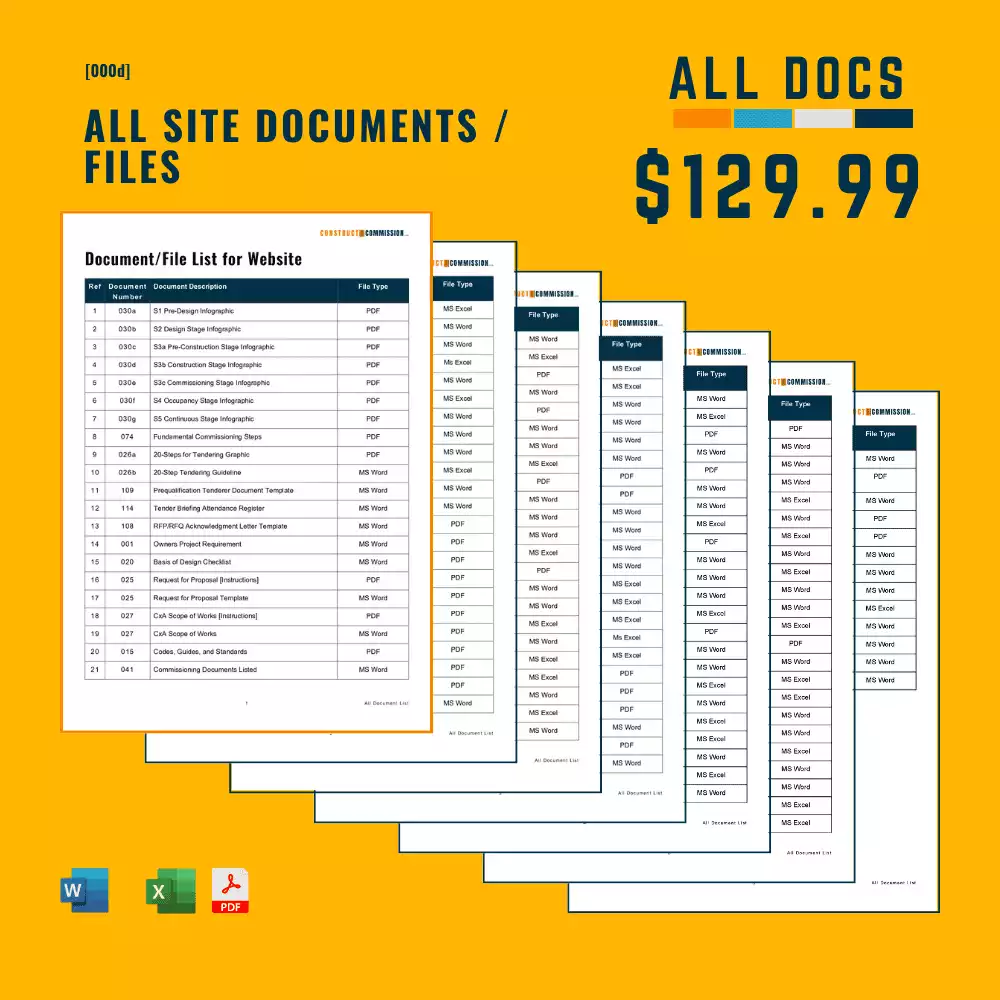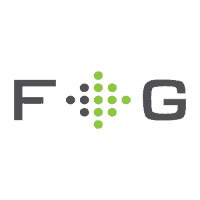A Scope of Works forms part of the tender package and is written to provide clear and detailed instructions of the works and expectations that are to be delivered by the successful tenderer. The document could also be referred to as the Scope of Services or Statement of Work.
In case you have not seen it, we have written the following documents directly linked to the Tendering Process.
What should a Scope of Work [SOW] include?, and how to write one for a Consultant?
For the SOW to be completed successfully and convey the correct information for a compliant proposal, the document should be written to incorporate the following information to the parties involved:
- Project background: Provide the reader with information related to the project and building that is being constructed.
- General Requirements / Objectives: Describe items such as Sustainability, Green Building needs, the current status of the project, unit measurements, regulations, and codes
- Services to be delivered: Provide a detailed written description of the tenderer’s services if awarded the project.
- Programme: Include information related to the project’s program [could refer to the RFP where it also can be covered].
- Qualifications of staff and company: Very important, clearly state any particular qualifications that the onsite team should possess for them to be accepted on the project.
- Commissioning Process to be used [if known]: The commissioning process should be detailed, [ACG, ASHRAE, BCxA, BSRIA, NEBB] to ensure the project meets the client’s expectations.
- Deliverables and Responsibilities: It is essential to clearly identify the expected deliverables within the commissioning process/works and who will be responsible for their delivery.
- Details on client documentation and information: Any particular information relating to the client’s documents should be provided. This would include any existing commissioning information etc.
- What information should be included within the proposal from the Tenderer: Include any specific items that should be covered by the tenderer that would help the evaluation process. Items such as certification, qualifications, example documentation, etc.
- Fee structure: To allow efficient review of the proposals, a fee structure should be that all tenderers are to complete.
- Attachments and appendices: Include any other documents and information required via any appendices.
Who writes the Scope of Work/Statement of Work?
For the Commissioning Consultant/Commissioning Agent, the Client team would write the Statement of Work.
This is why we felt it was a good article to include. Generally, in our experience, unless you are involved deeply and understand the commissioning process, the Scope is really quite hard to detail.
SCOPE OF WORKS [SOW] Template in MS Word [.doc] format to allow full editing with instructions.
Scope of Work [SOW] vs Statement of Work [SOW]
The Scope of Work and a Statement of Work are the same document.
- Statement of Work is more related to American terminology
- Scope of Work seems is more related to UK/European terminology
When should the Scope of Works / Schedule of Works be written and issued?
As noted in the RFP article, the commissioning manager is important for the project’s early progress, the Scope of Works should be written and issued before the Pre-Design Stage of the commissioning process starting.
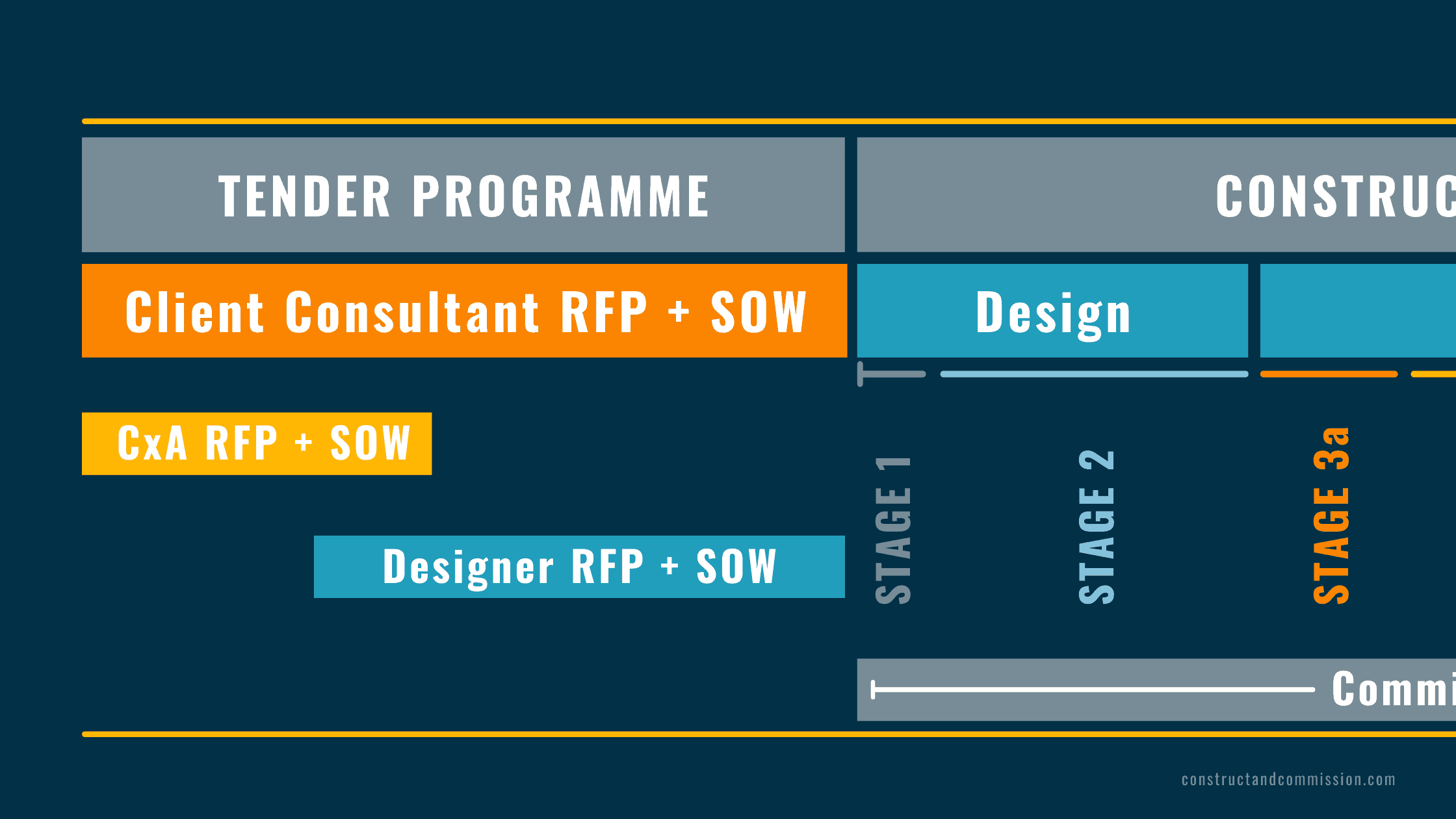
The commissioning team should be on the project and ready to start works, even before the design team – according to ASHRAE Guideline 0 – The Commissioning Process.
Scope of Work Template
Below we will detail a high-level layout that can be used for the above document.
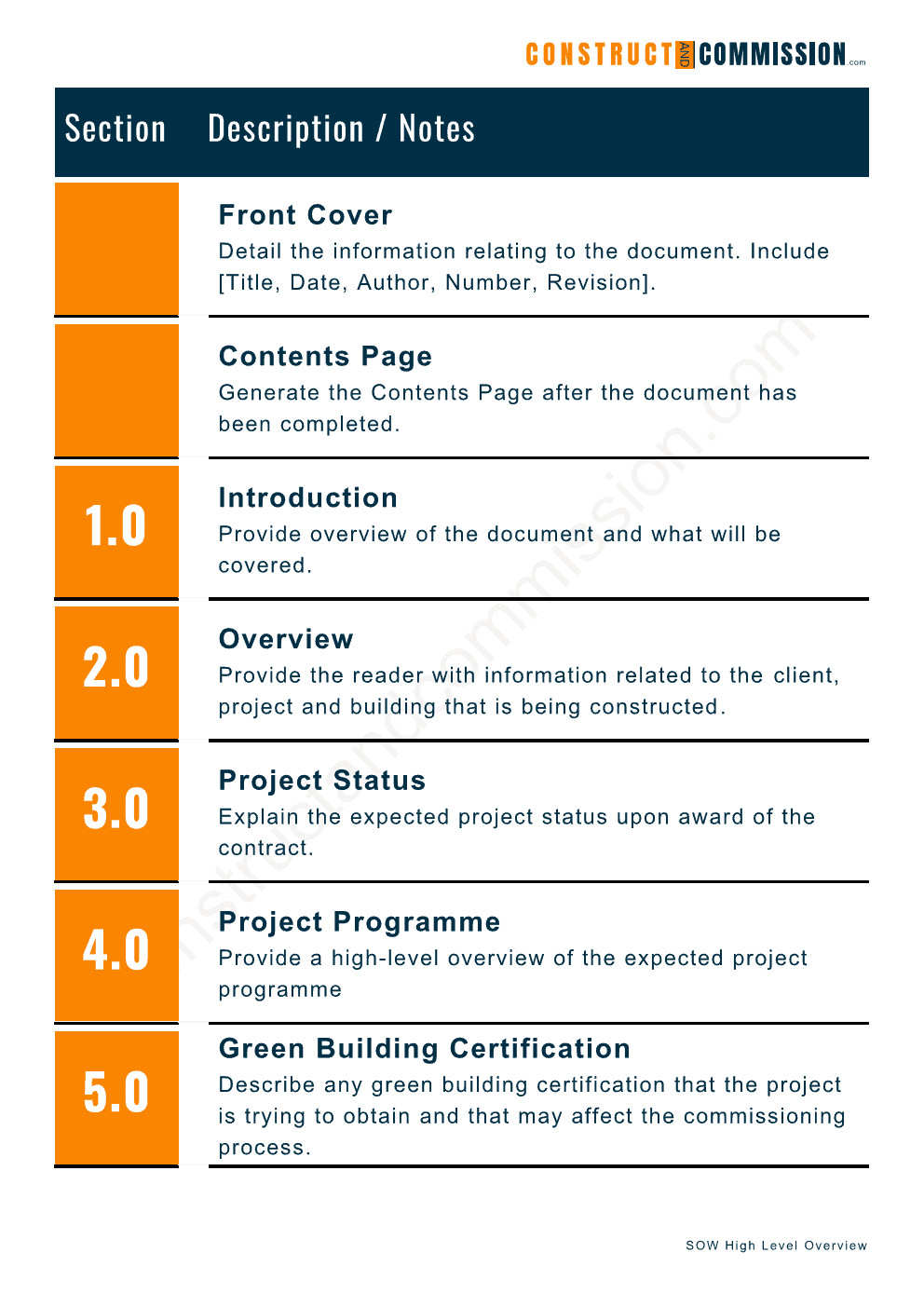
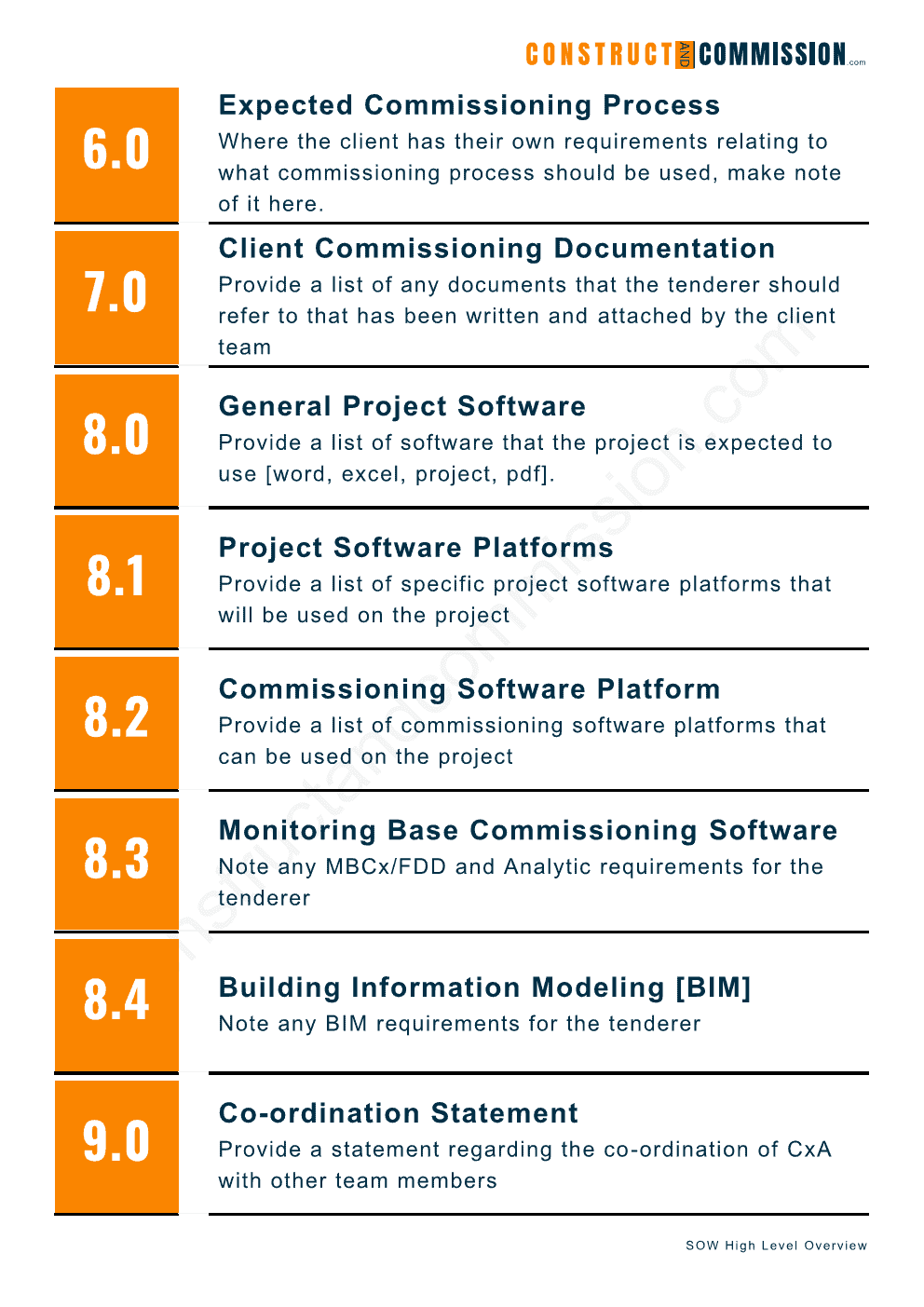
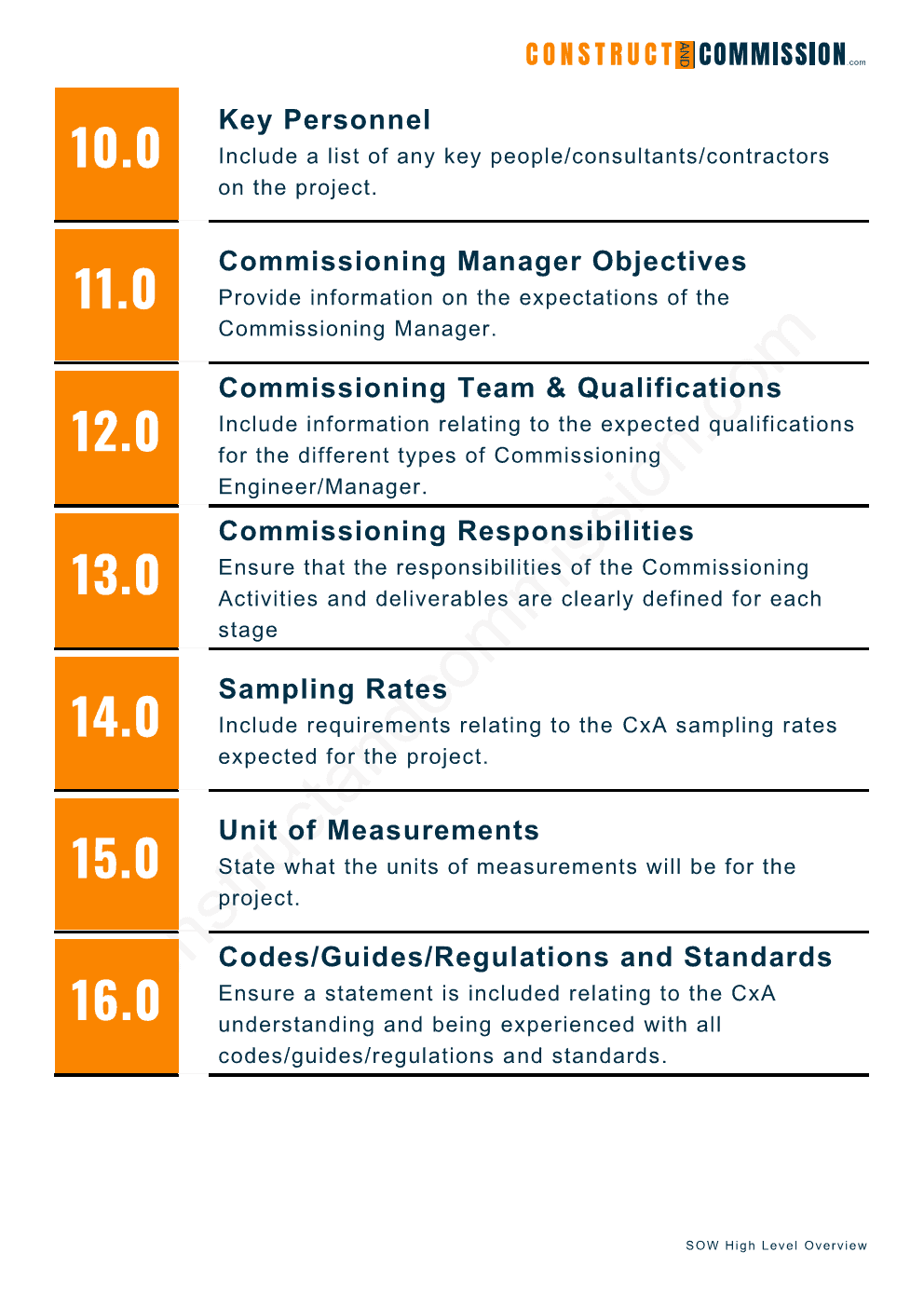
We have put together this bundle so you can get all related documents, and buying them together provides even better value [Over 50% Off], as shown below.
Included - 20 Tendering Steps Guideline Document | 20 Step Tendering Process Graphic | Tender Interview Agenda Example | Tender Interview Question Examples | Prequalification of Tenderer Document Template | CxA Request for Proposal [RFP] Template | CxA Scope of Work [SOW] Template | Acknowledgment of RFP/RFQ | Request For Information [RFI] Template | Request For Information [RFI] Tracker/Log.
Full Sample for Scope of Works
Front Cover
Detail the information relating to the document. Include [Title, Date, Author, Number, Revision].
Contents Page
Generate the Contents Page after the document has been completed.
1.0 Introduction
For this Scope of Works to be understood fully and to convey the correct information for a compliant proposal, the document has been written to incorporate the following information for the reference of the tenderers:
- Project background: Provide the tenderer with information related to the project and building that is being constructed.
- General Requirements / Objectives: Describe items such as Sustainability, Green Building needs, the current status of the project, unit measurements, regulations, and codes.
- Services to be delivered: Provide a detailed written description of the services that the tender is to deliver under this Scope of Works.
- Programme: Includes information related to the project’s program.
- Qualifications of staff and company: Clearly define any qualifications that the off/onsite team should possess for them to be accepted on the project.
- Commissioning Process to be used: Detail the commissioning process that will be used, to ensure the project meets the client’s expectations.
- Deliverables and Responsibilities: To ensure all taks are completed by the correct resource, the document will clearly identify the expected deliverables within the commissioning process/works and who will be responsible for their delivery.
- Details on client documentation and information: Provide information relating to information on the client’s documents. This will include any existing commissioning information etc.
- What information should be included within the proposal from the Tenderer: Describe any specific items that should be covered by the tenderer that will help the evaluation process. Items such as certification, qualifications, example documentation, etc.
- Fee structure: Include a clear fee structure, to allow efficient review across all tenderers.
- Attachments and appendices: Include any requirements of documents and information required via any Appendices.
2.0 Overview
This can be taken from the Request for Proposal [RFP]
2.1 Overview of the Client
This can be taken from the Request for Proposal [RFP]
2.2 Overview of the Project
This can be taken from the Request for Proposal [RFP]
Insert a description of the project here [use the table below to enhance the information if possible]
| Project Name: | [enter details] |
| Project Address: | [enter details] |
| Project Type: | [enter details] |
| Green Building Certification: | [enter details] |
| Number of Floors: | [enter details] |
| Number of Car Parking Spaces: | [enter details] |
| Construction Programme [Start/Completion]: | [enter details] |
| Commissioning Programme [Start/Completion]: | [enter details] |
| Defects Liability Period: | [enter details] |
3.0 Project Status
Based upon the Commissioning Scope of works detailed later, the expected status/phase of the project, once the CxA has been instructed, is highlighted below.
If the works are started later than the Pre-Design Phase/Stage, please ensure the Commissioning Team Responsibilities are understood as they may require tasks and deliveries from previous stages.

4.0 Project Programme
The below table details the anticipated and expected project high-level milestone dates, these can be used by the tenderer for their planning of activities.
| Pre Design Stage [1] | [enter expected dates] |
| Design Stage [2] | [enter expected dates] |
| Construction Stage [3] | [enter expected dates] |
| Commissioning Stage [4] | [enter expected dates] |
| Occupancy & Operations Stage [5] | [enter expected dates] |
| Continuous Commissioning Stage [6] | [enter expected dates] |
| Building Topped Out | [enter expected dates] |
| Building Water Tight | [enter expected dates] |
| Building Handover | [enter expected dates] |
| Defects Liability | [enter expected dates] |
5.0 Green Building Certification
The building and its systems have been designed and are intended to be operated in line with the following sustainability goals.
| LEED [World] | [Yes/No] Insert type |
| BREEAM [UK] | [Yes/No] Insert type |
| CASBEE [Japan] | [Yes/No] Insert type |
| CEEQUAL [UK] | [Yes/No] Insert type |
| Energy Star [USA] | [Yes/No] Insert type |
| Green Globes [USA] | [Yes/No] Insert type |
The tenderer should ensure that they have qualified resources to ensure the delivery of the certification for the commissioning works.
We have been asked several times to create a complete document package covering everything we have uploaded to the site.
So it's taken some time, but here it is....126No. Documents for you to download in Microsoft Word, Microsoft Excel & PDF Formats.
CLICK THE BUY HERE TO SEE/DOWNLOAD A FULL LIST OF DOCUMENTS INCLUDED...
6.0 Expected Commisisoning Process
[Where the client has their own requirements relating to what commissioning process should be used, make a note of it here.]
The client has noted that they aim to utilize the following Commissioning Process on the project. The tenderer should allow for this process within their proposal. Further details have been provided within the Commissioning Managers’ responsibility section.

7.0 Client Commissioning Documentation
The client would like to bring to the tenderer’s attention that the following commissioning documentation has been included within the tender package to provide additional detail of the scope and expectations for the project.
[Insert any documentation that may be relevant]
| Description | Document ID |
|---|---|
| [Add] | [Add] |
| [Add] | [Add] |
| [Add] | [Add] |
| [Add] | [Add] |
| [Add] | [Add] |
| [Add] | [Add] |
8.0 General Project Software
As the client is focused upon collaboration and efficiency, the tenderers should ensure that their complete team for the project is running and are fully experienced in using the following licensed software as a minimum for the project duration.
This will ensure that all project consultants and contractors use the same software, collaborate, and can work remotely if required.
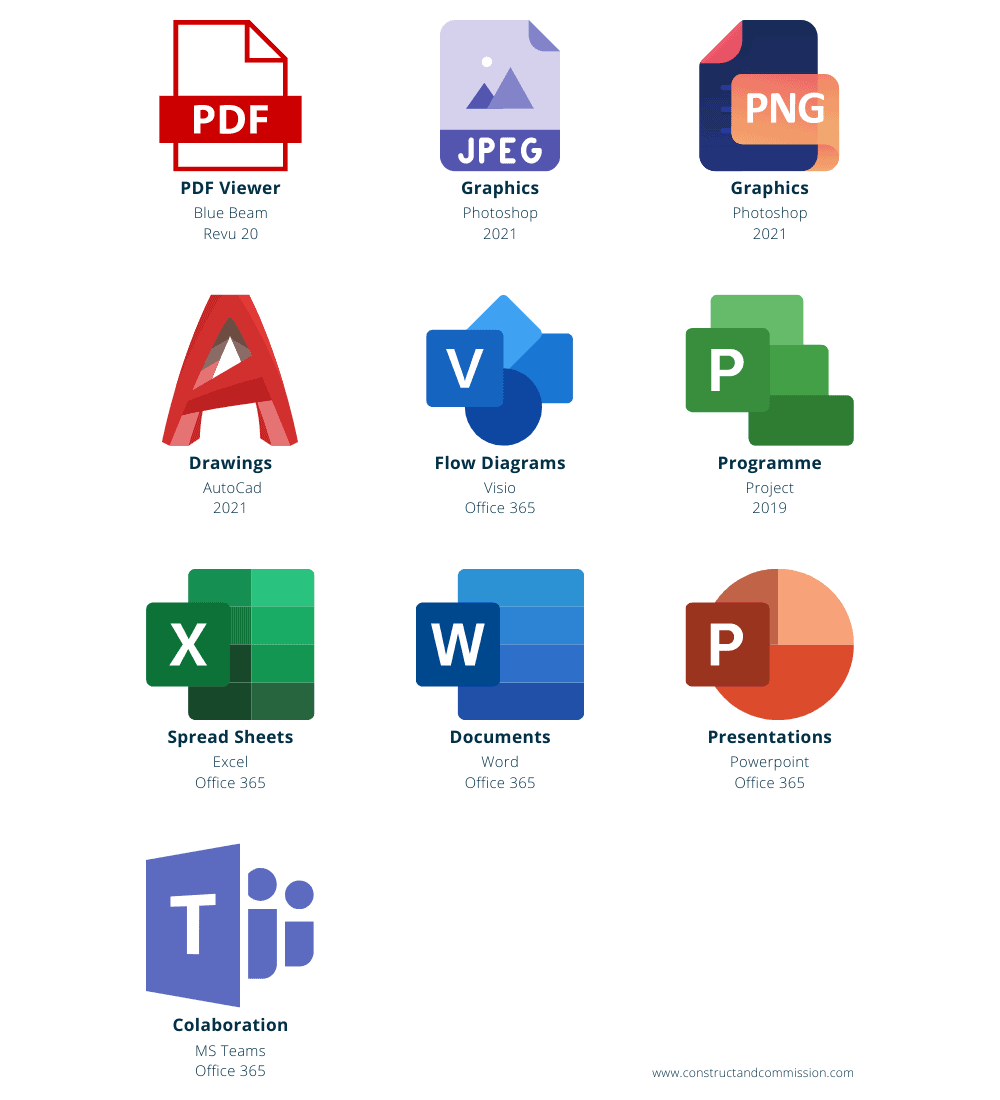
8.1 Project Software Platforms
The client has noted that the following software platforms will be utilized throughout the project.
The tenderers will be provided with login information and training from the client team. All systems are to be utilized throughout the construction process and programme.
| Description | Platform |
|---|---|
| Document Management | Aconex/A-Site [Update as required] |
| Defects Management | Aconex Field/SnagR [Update as required] |
| Operating and Maintenance Manuals | Aconex/A-Site [Update as required] |
8.2 Electronic Commissioning Platform
To ensure the commissioning process, factory testing, onsite testing, and closeout are managed most efficiently, the tenderer is to utilize a dedicated Commissioning Management Platform from the list below.
The tenderer is to ensure their teams are fully trained and understand how they are to operate the system and their responsibilities to keep all information fully up to date and live.
Platforms that are acceptable to be used on the project are as follows:
| Platform |
|---|
| BlueRithm |
| Facility Grid |
| Cx Alloy |
The tenderer will be responsible for the following relating to the Commissioning Platform, please ensure your proposal is compliant with the below:
| Description |
|---|
| Responsible for sourcing and purchasing the platform |
| Ensuring there are enough licenses for all client team, consultants, contractors, suppliers, and vendors to have access to the areas of the platform, enabling them to complete their works |
| Providing training to all users to ensure seamless usage |
| Setting up of all process steps, gates, and requirements to ensure that pre-requisites are completed before the next stages starting |
| Responsible for managing the access granted and setting up each user/company |
| Responsible for the uploading and managing of all testing and commissioning information. This will include, but not limited to, commissioning plan, commissioning reports, equipment schedules, factory testing method statements, pre-functional check sheets, functional test method statements, functional testing scripts, all reports, and final reports, including consolidating all testing and commissioning data for downloading then uploading to the client’s electronic document platform. |
| Ensure all defects and observations, including Cx design review issues, are logged and managed to close via the system |
| If the project is to incorporate a delivery via Levels 1,2,3,4,5 etc., fully manage that process and tagging off /on-site |
| Provide weekly reports on progress and issues found on the project relating to commissioning |
| Any issues noted on site relating to construction should be managed within the client’s defects systems for the project |
8.3 Monitoring Based Commissioning System and Building Analytics
The client will implement a monitoring-based commissioning platform on the project under a separate contract, but there will need to be some resources allowed by the Commissioning Agent.
The intention is that the system will be utilized during the Defects Liability Period to understand any system-wide issues that the project should address before the Defects Period ending.
The system will also be utilized to fine-tune the building’s mechanical and electrical systems to operate to their maximum efficiency upon DLP completion.
The Commissioning consultant’s works relating to this are detailed in the ‘Commissioning Responsibilities / Deliverables Section’ below.
8.4 Building Information Modeling
A building information modeling [BIM] system will in use on the project and will be delivered to LOD ***
The tenderer should make themselves aware of the following information and ensure that they have the correct experience within their team to deliver/monitor the requirements relating to this package.
| BIM Execution Plan, its contents, and process |
| Ensure that have experienced resources that understand how BIM works and using/uploading any information |
| Management of the commissioning element of the BIM delivery, including overseeing all commissioning information, where required, is inserted into the model, by the contractors, in the correct way and available to the operations team upon handover. |
9.0 Co-ordination Statement
The tenderer should ensure that they have allowed within their proposal to manage, coordinate, and collaborate with all other team members and contractors/vendors employed by the client related to their deliverables.
10.0 Key Personnel
The client should approve all key personnel expected to be used by the tenderer on the project.
The CVs of these key people should be attached to the proposal, including a portfolio of projects that they have competed in their positions proposed.
11.0 Commissioning Manager Objectives
The commissioning agent will be employed as an independent consultant to create, oversee, implement, manage and approve the commissioning process and deliverables for the project.
The CxA will verify and document that the building and its systems are planned, designed, installed, tested, operated, and able to be maintained. Meeting the Owners Project Requirements [OPR] and the design requirements of the facility and systems installed.
12.0 Commissioning Team & Qualifications
The client requires that the Commissioning Managers team comprises of engineers who have commissioning expertise in each of the systems being commissioned.
The tenderer should ensure they have a team of staff and, where used, sub-consultants assigned and committed to the project.
The tenderer should provide a Lead Commissioning Manager who will lead and coordinate all on/off-site activities and manage the commissioning discipline engineers within their teams.
The client will judge the experience and knowledge of the tenderers team by a mix of qualifications and experience.
The tenderer should ensure that each team member holds industry-recognized qualifications relating to commissioning and the delivery of the commissioning process and TAB works.
The following associations will be accepted:
- AABCC Commissioning Group [ACG]
- ASHRAE
- BCxA
- NEBB
13.0 Commissioning Responsibilities / Deliverables
The below provides a high-level overview of the expected deliverables relating to the Commissioning Process for the project.
13.1 Stage 1 – Pre-design Phase
| Ref | Deliverable |
|---|---|
| 1-1 | Commissioning Team to be formed |
| 1-2 | Write and develop the owner’s project requirements (OPR) document and manage the basis of design document (BOD), including any meetings and workshops. |
| 1-3 | Understand and develop the commissioning budget & scope |
| 1-4 | Write the initial Commissioning Plan |
| 1-5 | Set up an electronic system for commissioning management |
| 1-6 | Manage acceptance requirements |
| 1-7 | Manage general commissioning documentation |
| 1-8 | Identify training requirements |
13.2 Stage 2 – Design Phase
| Ref | Deliverable |
|---|---|
| 2-1 | Review and ensure that the construction documents meet and properly convey the OPR. Create reports, update the document, and track observations and resolutions where required. |
| 2-2 | Aid in preparing requests for proposals and scope of works. Ensure that the commissioning process activities are clearly stated in all project scopes of work. |
| 2-3 | Enhance and update the scope and budget for project-specific commissioning process activities. |
| 2-4 | Conduct and minute any commissioning meetings. |
| 2-5 | Integrate the commissioning deliverables and activities into the project schedule. |
| 2-6 | Ensure, where required, the basis of design document [BOD] is updated. |
| 2-7 | Create checklists. |
| 2-8 | Create and develop the construction, commissioning & occupancy, and operations phase test requirements. |
| 2-9 | Detail the training program requirements. |
| 2-10 | Update the Commissioning Plan. |
| 2-11 | Complete targeted commissioning-focused review at strategic times during the Design Phase. All issues should be resolved before continuing with the design. |
| 2-12 | Update the owner’s project requirements. |
| 2-13 | Continually update all Commissioning Reports. |
| 2-14 | In coordination with the client, review and select software related to the monitoring-based commissioning system [as per stage 5 of the process]. |
13.3 Stage 3 – Construction Phase
13.3.1 Stage 3a – Pre-Construction Phase
| Ref | Deliverable |
|---|---|
| 3a-1 | Complete a focused commissioning review of the design drawings to ensure that the design meets the commissioning process requirements and testing requirements. |
| 3a-2 | Revise the commissioning specification with any updated information required. |
| 3a-3 | Review and ensure that the construction documents meet and properly convey the OPR. Create reports, update the document, and track observations and resolutions where required. |
| 3a-4 | Update the commissioning plan to reflect approved changes made to the OPR and including any additional information. |
| 3a-5 | Update/develop a fully sequenced and detailed testing and commissioning programme. |
| 3a-6 | Write, develop and finalize the project testing and commissioning procedures. |
| 3a-7 | Review and understand the project requirements for all final documents and numbering systems etc. Implement with the contractors. |
| 3a-8 | Understand and stipulate all requirements of Factory Acceptance Testing & Mockups that are required. |
| 3a-9 | Explain the commissioning process to the specialist trade contractors during the tender and appointment process. |
| 3a-10 | Understand the capability of the specialist trade contractors to meet the requirements of the commissioning process. |
| 3a-11 | Create the training programme and information |
| 3a-12 | Coordinate and manage the sign off of the BMS graphics & Points lists with the client team and contractors [contractors to produce and write the documents] |
13.3.2 Stage 3b – Construction Phase
| Ref | Deliverable |
|---|---|
| 3b-1 | Oversee and where applicable lead commissioning workshops, document, and minute. |
| 3b-2 | Issue the detailed commissioning programme to the project teams |
| 3b-3 | Update commissioning review information by completing a construction drawing-focused analysis on commissioning and maintenance of systems. |
| 3b-4 | Review and comment upon any material submissions focusing on testing and commissioning items relating to the plant. |
| 3b-5 | Oversee pre-commissioning works, involving verification of the installations and any functional/onsite testing. |
| 3b-6 | Verify and document that the required performance outcomes have been achieved via test execution. |
| 3b-7 | Ensure that the training requirements/documentation is being met and planned with the relevant parties. |
| 3b-8 | Oversee and manage the installation of the monitoring-based commissioning system. |
13.3.3 Stage 3c – Commissioning Phase
| Ref | Deliverable |
|---|---|
| 3c-1 | Manage the facilities management team to observe and witness the testing works. |
| 3c-2 | Ensure that all documentation is in place. |
| 3c-3 | Witness the setting to work of the building’s systems and plant, verifying that requirements have been achieved. |
| 3c-4 | Performance test the buildings systems and plant in line with the project-approved method statements. |
| 3c-5 | Update final commissioning plan. |
| 3c-7 | Issue the construction stage commissioning reports. |
| 3c-6 | Manage and verify that the systems / O&M manual is being created and written, including all relevant data relating to testing and commissioning. |
| 3c-7 | Review and ensure that the project meets and properly conveys the OPR. Create reports, update the document, and track observations and resolutions where required. |
| 3c-8 | Oversee and manage the commissioning of the monitoring-based commissioning system |
13.3.4 Stage 4 – Occupancy & Operations Phase
| Ref | Deliverable |
|---|---|
| 4-1 | Manage contractor callbacks relating to commissioning items and monitoring-based commissioning activities. |
| 4-2 | Manage reporting and coordination of works and activities relating to the monitoring-based commissioning system. |
| 4-3 | Manage and witness any seasonal testing of facility systems and assemblies. |
| 4-4 | Ensure that all operation and maintenance personnel are trained or that it is ongoing. |
| 4-5 | Review and ensure that the project meets and properly conveys the OPR. Create reports, update the document, and track observations and resolutions where required. |
| 4-6 | Updating of the Systems Manual & final works relating to operating and maintenance manuals. |
| 4-7 | Conduct and verify periodic performance evaluations of facility systems and assemblies in line with clients’ monitoring-based commissioning. |
| 4-8 | Complete a lessons-learned workshop. |
| 4-9 | Complete the final commissioning report for the project. |
13.3.5 Stage 5 – Continuous Commissioning Phase [period of DLP]
| Ref | Deliverable |
|---|---|
| 5-1 | Obtain reports and information relating to the system operations |
| 5-2 | Manage any defect remedial works detected in the system |
| 5-3 | Manage any optimization of the system to allow more efficient operation in line with advice |
| 5-4 | Verify system and assembly operations meet updated Owner’s Project Requirements. |
| 5-5 | Update all reports / manuals. Issues systems manual and final commissioning report |
14.0 Sampling Rates
For further reading, we have written the following article on Sampling Rates and How to Use them.
To ensure that the documents, systems, and installations are reviewed, inspected, and witnessed, the client expects the following sampling rates to be adhered to:
14.1 Contractor Documentation [all stages/phases]
The Commissioning Agent should ensure that the contractor completes and submits 100% of the required documents related to the commissioning activities of the project and that everything has been included within the Operating and Maintenance Manuals, Systems Manual, and Final Commissioning Report.
14.2 Commissioning Agent Review/Comments/Approval of Documents
The commissioning manager should allow for the following relating to reviewing and approving the testing and commissioning documentation.
| All Documents. [inc but not limited to, method statements, scripts, reports, programs, test data, and information related to operating and maintenance manuals] | [Add]% |
14.3 Commissioning Agent Factory Acceptance Testing Review/Inspection and Verification
| All Factory Acceptance Testing. [method statements, attendance, reports] | [Add]% |
14.4 Onsite Construction Review/Inspection and Verification
| Type [system etc] | % to Witness/Inspect |
| Builders Work Items | [Add]% |
| Electrical Systems (non-critical) | [Add]% |
| Electrical Systems (critical) | [Add]% |
| Elv Systems (non-critical) | [Add]% |
| Elv Systems (critical) | [Add]% |
| Fire Systems / Life Safety Systems | [Add]% |
| Mechanical Systems / HVAC (non-critical) | [Add]% |
| Mechanical Systems / HVAC (critical) | [Add]% |
| Plumbing & Drainage (non-critical) | [Add]% |
| Plumbing & Drainage (critical) | [Add]% |
| Other Systems (non-critical) | [Add]% |
| Other Systems (critical) | [Add]% |
15.0 Units of Measurements
The project will use the metric system as the unit of measurements.
16.0 Codes/Guides/Regulations and Standards
The tenderer should make themselves aware of all of the codes, guides, and standards that will need to be adhered to via:
- Project documentation
- Local requirements
- Country national requirements
Appendices
The following should be included within the Appendices
| Appendix A | MEP, F, ELV & BMS General Specifications |
| Appendix B | MEP, F, ELV & BMS Particular Specifications |
| Appendix C | MEP, F, ELV & BMS Schematics |
| Appendix D | MEP, F, ELV & BMS Layouts |
| Appendix E | BMS Points List |
| Appendix F | Control Logics |
| Appendix G | Plant Schedules |
⬛ Related Articles
TENDER INTERVIEWS | Simple Guide
ACKNOWLEDGMENT OF RFP/RFQ | with Simple Letter and Email Template
[RFP] CxA REQUEST FOR PROPOSAL | How to Write and Format with Downloads
RFP / RFQ TENDERING PROCESS | How to Complete in 20 Steps
RFI vs RFQ vs RFP | Understanding the Differences


![CxA Scope of Works [SOW] Template [MS Word]](https://constructandcommission.com/wp-content/uploads/2022/01/027.webp)
